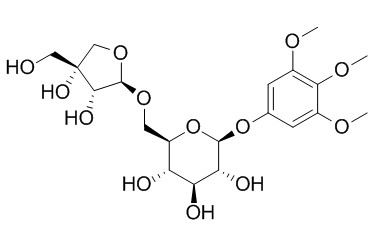Kelampayoside A
Kelampayoside A is a natural product from Callicarpa peii.
Inquire / Order:
manager@chemfaces.com
Technical Inquiries:
service@chemfaces.com
Tel:
+86-27-84237783
Fax:
+86-27-84254680
Address:
1 Building, No. 83, CheCheng Rd., Wuhan Economic and Technological Development Zone, Wuhan, Hubei 430056, PRC
Providing storage is as stated on the product vial and the vial is kept tightly sealed, the product can be stored for up to
24 months(2-8C).
Wherever possible, you should prepare and use solutions on the same day. However, if you need to make up stock solutions in advance, we recommend that you store the solution as aliquots in tightly sealed vials at -20C. Generally, these will be useable for up to two weeks. Before use, and prior to opening the vial we recommend that you allow your product to equilibrate to room temperature for at least 1 hour.
Need more advice on solubility, usage and handling? Please email to: service@chemfaces.com
The packaging of the product may have turned upside down during transportation, resulting in the natural compounds adhering to the neck or cap of the vial. take the vial out of its packaging and gently shake to let the compounds fall to the bottom of the vial. for liquid products, centrifuge at 200-500 RPM to gather the liquid at the bottom of the vial. try to avoid loss or contamination during handling.
Chemistry of Natural Compounds2018, 204-206
Pharmacol Rep.2018, 70(6):1195-1201
Sci Rep. 2024, 14(1):70.
Front Cell Dev Biol.2021, 9:638174.
LWT2020, 126:109313
Mol Biol Rep.2022, doi: 10.1007
Pharmacognosy Journal.2020, 12(2), p232-235.
J Pharmaceutical and Biomedical Analysis2022, 114631.
Nutrients.2024, 16(16):2612.
Antioxidants (Basel).2020, 9(4):284.
Related and Featured Products
Zhongguo Zhong Yao Za Zhi. 2010 May;35(10):1261-71.
Chemical constituents of stems and branches of Adina polycephala.[Pubmed:
20707194]
To investigate chemical constituents of the stems and branches of Adina polycephala and their pharmacological activities.
METHODS AND RESULTS:
The constituents were isolated by a combination of various chromatographic techniques including column chromatography on silica gel, Sephadex LH-20, and C-18, as well as reversed-phase HPLC. Structures of the isolates were identified by spectroscopic data analysis. In vitro cytotoxic, anti-inflammatory, anti-oxidant, anti-HIV, neuroprotective and anti-diabetic activities were screened by using cell-based models.
Twenty-eight constituents were isolated. Their structures were identified as clemochinenoside B (1), Kelampayoside A (2), osmanthuside H (3), 4-hydroxy-3-methoxyphenol-beta-D-[6-O-(4-hydroxy-3,5-dimethoxylbenzoate)]-glucopyranoside (4), and syringic acid beta-D-glucopyranosyl ester (5). Ten iridoidal glycosides: geniposidic acid (6), geniposide (7), 6beta-hydroxygeniposide (8), 6beta-hydroxygeniposide (9), ixoside (10), ixoside 11-methyl ester (11), 11-methyl forsythide (12), 7beta-hydroxysplendoside (13), gardoside (14) and mussaenosidic acid (15), (+) -pinoresinol (16), (+) -medioresinol (17), (+) -syringaresinol (18), (-)-lariciresinol (19), evofolin-B (20), alpha-hydroxyacetovaillone (21), syringic acid (22), vanillin (23), 3, 4, 5-trimethoxyphenol (24), and 2,6-dimethoxy-1, 4-benzoquinone (25), beta-sitosterol (26), mannitol (27), and daucosterol (28). At a concentration of 1.0 x 10(-5) mol x L(-1), these compounds were inactive in the assays, including cytotoxicity against human tumor cell lines (HCT-8, Bel-7402, BGC-823, A549 and A2780), anti-inflammatory activity against the release of beta-glucuronidase in rat polymorphonuclear leukocytes (PMNs) induced by platelet-activating factor (PAF), antioxidant activity in Fe(2+)-cystine-induced rat liver microsomal lipid peroxidation, anti-HIV activity against HIV-1 replication, neuroprotective activity against serum deprivation or glutamate induced neurotoxicity in cultures of PC12 cells, and the inhibitory activity against protein tyrosine phosphatase 1B (PTP1B).
CONCLUSIONS:
Compounds 1-20 were obtained from the genus Adina for the first time. The 13C-NMR data of compounds 10 and 11 were reassigned. A further evaluation of pharmacological activity of these compounds is expected.
Zhong Yao Cai. 2013 Apr;36(4):563-6.
Study on chemical constituents of Callicarpa peii.[Pubmed:
24134001]
To study the chemical constituents of Callicarpa peii.
METHODS AND RESULTS:
The chemical constituents were isolated and purified by chromatographic methods and elucidated by spectral analysis, including UV, IR, MS, 1H-NMR and 13C-NMR.
Ten compounds were obtained and identified as oleanolic acid (1), 2beta, 3beta,19alpha-trihydroxy-12-en-28-ursolic acid (2), luteolin -7,4'-dimethylether (3), luteolin -3', 4', 7, -trimethylether (4), luteolin -4'-methylether (5), hydnocarpin (6), luteolin (7), lyoniresinol 3alpha-O-beta-D-glucopyranoside (8), Kelampayoside A (9), kaempferol -3-O-glucuronide (10).
CONCLUSIONS:
All these compounds are isolated from Callicarpa peii for the first time and compounds 3, 4, 6, 8 and 10 are isolated from this genus for the first time.



